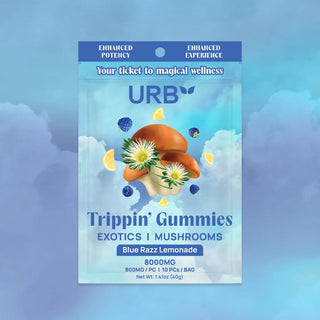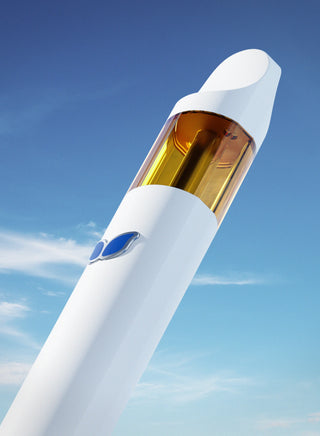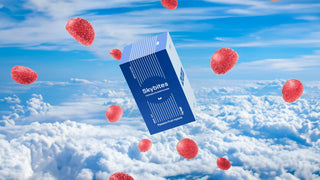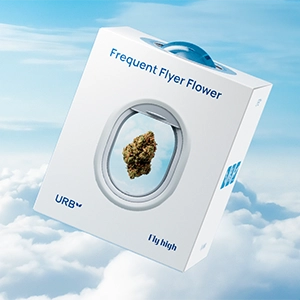Cannabis terpenes are endlessly intriguing. These naturally occurring aromatic oils are what give each strain its distinct scent and flavor profile—ranging from musky and earthy to citrusy, spicy, and beyond. But their role goes far deeper than aroma alone. As emerging scientific research continues to uncover, terpenes may play a part in shaping the overall cannabis experience by influencing how the plant interacts with our body’s systems.
One such system is the endocannabinoid system (ECS)—a complex, built-in regulatory network that helps maintain balance across a range of bodily functions, including mood, memory, appetite, and immune response. While the full picture of how terpenes engage with the ECS is still developing, early research suggests these compounds may interact with key receptors in nuanced ways, potentially contributing to the overall entourage effect.
At Urb, we’re fascinated by the way terpenes add depth, personality, and purpose to every cannabis experience. In this guide, we’ll take a closer look at three earthy, spicy terpenes that stand out in our True-Infused Terpene profiles: myrcene, humulene, and caryophyllene. These bold, aromatic terpenes do more than turn heads with their scent—they help shape the character, depth, and overall vibe of every cannabis experience we craft.
What Is Myrcene?
If you love that classic rich, musky, earthy scent of cannabis, you have the terpene myrcene to thank. Besides cannabis, you’ll find it in all sorts of unexpected places, including many foods and beverages, perfumes and cosmetics, and soaps and detergents. In the cannabis world, it’s often known as “the mother of all terpenes” for its ability to work with other terpenes and cannabinoids.

What makes myrcene’s scent so compelling? Something about it toes the line between bewitching and … well, pungent and dank. For those who love ambiguity in their aromas, there’s simply nothing that compares. With its bold and empowering qualities, it’s a major reason why you’ll find it in many of our products.
Scent & Taste
If there’s one thing everyone agrees on, it’s that myrcene isn’t exactly subtle. Some of the descriptors for its aroma include dank, gassy, intensely herbal, and akin to a wet forest floor.
As for its flavor, myrcene presents a slightly different side. While it’s still earthy and musky, spice-like elements also emerge, reminding some fans of cloves or cinnamon and others of the tropical edge found in mangoes—especially their peels.
What Is Myrcene Found In?
Outside of its starring role in cannabis, myrcene appears in many significant plants and herbs. It’s a key component of thyme, lemongrass, and bay leaves, among others. It’s also a vital sensory component of mango and even some citrus fruits, where it deepens the clean, floral bite of limonene.
The terpene is also a major element in hops, the plant that serves as the main flavoring agent in beer. As a result, beer lovers will recognize some of the same bitter, earthy, and peppery notes myrcene produces in their favorite beverages.
Reported Benefits & Effects of the Mycene Terpene
Emerging scientific studies suggest myrcene may influence the way cannabinoids interact with the body. One 2021 paper published in Frontiers in Nutrition highlights how myrcene could impact membrane permeability, possibly modifying how other compounds are absorbed and processed by our bodies.
Another 2002 study explored its potential modulation of nociception (the sensory perception of pain) and sedative effects in animal models—though these findings don’t translate directly to cannabis product effects without further research.
A third study from 2019 supports myrcene’s use in traditional medicine practices and its interaction with other cannabinoids, offering a potential role in the “entourage effect.”
What Is Humulene?
Woodsy, earthy, and spicy, the humulene terpene is another heavy hitter in the cannabis realm. Like myrcene, it’s associated with the scent of hoppy beer, as it’s a major aromatic component of the hop plant. However, it also appears in many common herbs and spices. Strong yet subtle, herbal yet bracing, it’s a terpene that lends its properties to a wide variety of cannabis products and strains.

Scent & Taste
If myrcene is instantly recognizable as an earthy, musky scent, the humulene terpene puts its own spin on these deep aromas. Woodsy, spicy, and floral, humulene’s sensory profile is less brash than myrcene’s, and you may also detect notes of tobacco, fragrant wood, and toastiness.
Those who’ve tasted pure humulene sometimes describe it as bitter, but there’s more to the picture. Sit with it, and you’ll find fruity, spicy, and dry herbal notes, making humulene one of the most enticing of the many terpenes in the natural world.
What is Humulene Found In?
Though humulene is most commonly associated with the aromatic notes of beer, it casts a much wider net. A major component of cloves, juniper, and black pepper, it also fortifies leafy and resinous herbs such as sage, coriander, oregano, rosemary, and more.
Reported Effects and Benefits of the Humulene Terpene
Humulene does more than bring its signature earthy spice to cannabis—it’s also caught the attention of researchers for what it might be doing behind the scenes. Found in familiar herbs like hops, sage, and black pepper, this terpene doesn’t just smell great—it’s being studied for how it could interact with the body in ways we’re only beginning to understand.
Scientists have been taking a closer look at humulene to see how it might influence some of the body’s natural responses—especially around inflammation. In one early study published in the European Journal of Pharmacology back in 2004, researchers explored how humulene interacted with certain immune pathways in lab models. The results pointed to some interesting activity—but like with most terpene research, it’s still early days in the scientific understanding of this terpene’s potential.
Other studies have observed humulene’s antimicrobial potential in vitro, particularly against certain strains of bacteria. While promising, these findings are early-stage research and are not representative of effects in human cannabis use.
Researchers have also looked into how humulene might be studied further in the context of digestive health and inflammatory conditions. But at Urb, we focus on what’s certain: humulene’s bold, spicy profile and its ability to elevate the sensory character of our terpene blends.
What Is Caryophyllene?
If you like a bit of spice in your life, there’s a good chance you’ll love the peppery, spicy, and altogether assertive caryophyllene (or beta-caryophyllene) terpene. Reminiscent of black pepper, where it occurs in high concentrations, this terpene lends select cannabis strains and products their in-your-face kick.
Popular in aromatherapy for its woodsy and spicy notes, used in topicals for its soothing potential, and used as a flavoring additive in many foods and beverages thanks to its peppery, cinnamon-like bite, it’s definitely among the top cannabis terpenes you should know.
Scent & Taste
As with myrcene and humulene, caryophyllene has a main association: The bracing smell of black pepper. But like those other top terpenes, there’s much more to the story. You’ll get that hit of spice, but behind it are the warming scents of cinnamon, cloves, and exotic copaiba oil.
What Is Caryophyllene Found In?
In the culinary world, caryophyllene lends its distinctive taste to black pepper and cinnamon, along with basil, cloves, and rosemary. It’s also a chief contributor to some truly fascinating plants, helping give the ylang-ylang flower—a medicinal plant found throughout the Pacific region and Asia—its distinctive scent.
Reported Effects and Benefits of the Caryophyllene Terpene
Caryophyllene is unique among terpenes in that it can directly bind to the body’s CB2 receptors—which are part of the endocannabinoid system—our body’s internal balance network. These CB2 receptors are the components of the endocannabinoid system largely associated with immune modulation. This has made it a subject of increasing scientific interest, particularly in studies exploring the broader "entourage effect" of cannabis constituents. What’s especially intriguing is that, unlike THC, caryophyllene interacts with these receptors without producing intoxicating effects.
A 2008 study published in Neuropsychopharmacology even referred to it as a “dietary cannabinoid”, highlighting its special role among plant compounds and opening the door for more research into how it might influence mood, stress, and the way we process certain experiences.
Another 2016 review, published in Frontiers in Pharmacology, examined how this terpene may interact with inflammation, stress response, and mood-related pathways. Again, the findings are preclinical—but they paint a compelling picture of caryophyllene’s complexity.
In the wake of the COVID-19 pandemic, scientists also began exploring the role compounds that can bind to our CB2 agonists—including caryophyllene—play in the context of immunity and inflammation. A 2021 study in Medical Hypotheses speculated on its potential contribution to immune resilience through CB2 signaling. While purely theoretical, this line of inquiry showcases the evolving research interest in this non-psychoactive terpene.
Spice Up Your Next Session With Urb
As members of the largest and most diverse group of compounds in the natural world, terpenes are major players in the aromas and flavors found in countless plants—and even some insects. At Urb, we lean on these terpenes for their very special blend of spicy and earthy notes in our True-Infused Terpene blends.
Myrcene’s deep, musky aroma is one of the defining scents of cannabis—it’s earthy, bold, and unmistakably complex. Humulene adds a woodsy, slightly bitter edge and plays a key role in the signature scent of hops, which is why you’ll often catch a familiar note if you’re a fan of craft beer. Caryophyllene turns up the heat with its peppery spice and stands out for its ability to interact with the body’s endocannabinoid system.
While early studies have explored how these terpenes might influence certain biological pathways, what we know for sure is this: together, they elevate the sensory richness of the cannabis experience and help define the feel, flavor, and vibe of our terpene-forward blends.
Curious to experience these terpenes for yourself? We’ve got you covered—explore Urb’s Terpene Guide to learn more about all our hand-picked terpenes and access our curated terpene collections.
Note: The findings and research studies referenced above are part of ongoing research and do not reflect effects associated with Urb products. We share this information for educational purposes only.















